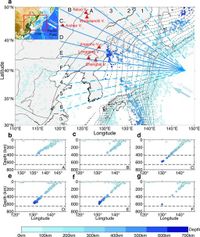In a groundbreaking study about intraplate volcanism in northeast China, researchers have shed light on the enigmatic connections between the Changbaishan volcanic field and deep-focus earthquakes in the region. Using advanced teleseismic double-difference tomography, they have produced high-resolution images of the subducting Pacific slab that reveals a narrow slab tongue penetrating the lower mantle, which is flanked by stagnant slabs in the mantle transition zone. This unique morphology suggests that hot material from deep within the Earth can ascend through the slab gap, providing a potential source for the renowned Changbaishan volcanism.
The Changbaishan volcanic field (CVF), known for its significant historical eruption in 946-947 AD, is situated approximately 1500 km from the Japan Trench and 1200 km behind the main volcanic arc. This location has puzzled scientists for years, as extensive volcanic activity occurs far from traditional subduction zone influences. The study found that the basaltic melts from the CVF possess an ocean island basalt (OIB) affinity, which indicates that their source originates from deep within the mantle.
Key findings of the research indicate that the geodynamics of the area are influenced by the interaction between the subducting Pacific slab and the surrounding mantle. The researchers identified a clear pattern: the subducting slab stagnates within the mantle transition zone (MTZ) on either side of a narrow section that penetrates deeply into the lower mantle. This bifurcation is not merely a static phenomenon; it is associated with active deformation that can cause earthquakes in the vicinity, particularly concentrated at depths between 500 to 600 km.
Historical data suggests that major basalt eruptions in the CVF started around 16 million years ago, coinciding with the subduction of the Pacific Plate, which began to stagnate at a depth of 15 million years. The researchers propose that the resulting slab gap not only contributes to volcanic activity but also governs the occurrence of deep-focus earthquakes. The interaction creates an environment for hot materials to rise from the lower mantle, which leads to the formation of volcanic phenomena like those seen in Changbaishan.
Moreover, the unique morphology of the slab has implications that extend beyond volcanism. The spatial correlation between the cluster of deep-focus earthquakes and the slab's dynamics suggests that the rate of deformation in subducting slabs may significantly determine where and how intensely deep-focus earthquakes occur. The study reinforces hypotheses that variations in slab morphology can lead to differing patterns of seismicity.
The research employed a teleseismic double-difference tomography method, which synthesizes thousands of seismic wave arrival times to generate detailed images of the slab structure. Through this innovative approach, the researchers have improved our understanding of the connections between deep earth processes and surface volcanic activity.
These findings not only provide insights into the workings of the Changbaishan volcanism but also contribute to the wider understanding of mantle dynamics beneath northeastern China. They emphasize the need to consider deep geological structures when examining intraplate volcanic systems, potentially challenging existing models of slab interactions.
In conclusion, the study highlights the dynamic relationship between slab morphology and volcanic activity, demonstrating that the physical structures beneath the surface can have profound effects on geological phenomena. This research opens up avenues for further studies focusing on the mechanics of deep earthquakes, providing essential groundwork for understanding seismic hazards in regions influenced by slab dynamics.




